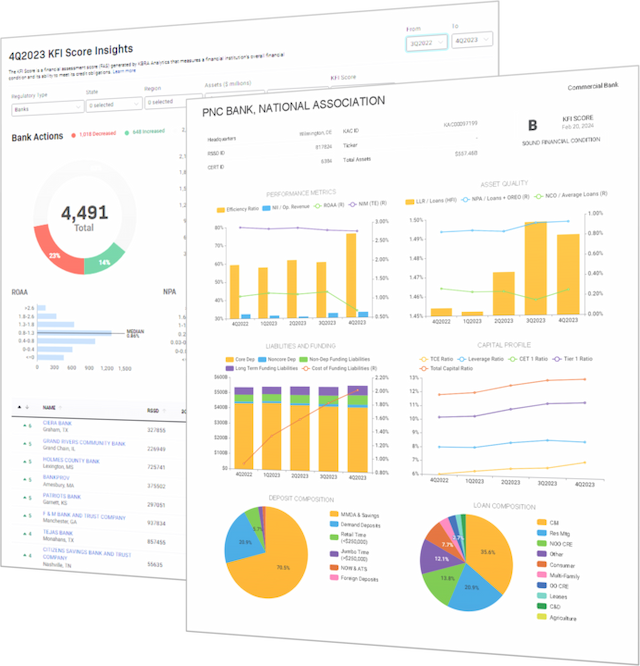KBRA Financial Intelligence
U.S. Banks Bear the Brunt of an Aging America
By KFI Staff
Over 85% of U.S. Metro Areas Are Growing Older
U.S. Census data indicates that American population growth has staged a rebound throughout the past five years, reaching a 23-year high in 2024 when the rate of growth surpassed the 10-year moving average for the second consecutive year. That said, the U.S. population continues to age, with the median age now exceeding 39 years. This marks a year-over-year increase in 329 of the nation’s 387 metropolitan statistical areas (MSA). According to the U.S. Census, older adults now outnumber children in nearly half of all U.S. counties.

Population aging has significant implications for the banking industry, as older Americans—particularly retirees—are unlikely to contribute to deposit growth at the same pace as in the past and are generally expected to begin drawing down their bank deposit balances as they continue to age. Further, demand for credit is likely to be lower among the oldest Americans when compared to younger generations. Perhaps most concerning for many regional and community-sized institutions is the risk of losing critical relationships in aging client bases—particularly if no relationship is maintained with their estate heirs.
Fastest-Aging Areas Exhibiting Slower Deposit Growth
To represent the growing share of the senior population, we constructed an over age 60/under age 60 ratio (O60/U60) in each MSA in the U.S. In a series of Census data spanning 2013-2023, this ratio has ballooned to 0.34 from 0.24, representing an increase of nearly 20 million in the O60 population and a decrease of 2.9 million in the U60 population.

By utilizing FDIC Summary of Deposits (SOD) data available on KFI’s platform, we cross-referenced the O60/U60 ratio with deposit totals for 366 U.S. MSAs that have remained present in each year of Census data since 2013. Sampling two cohorts of 50 MSAs that experienced the smallest and largest increases in their respective O60/U60 ratios reveals a divergent path in deposit growth throughout the past decade, a trend that has become particularly prevalent since 2019. For simplicity, we will refer to MSAs experiencing the smallest increase in the O60/U60 ratio as the small change group (SCG) and MSAs experiencing the largest increase as the large change group (LCG) for the remainder of the analysis.
SCG average deposit growth between 2013 and 2023 was equivalent to roughly 84%, surpassing average deposit growth of just 68% in the LCG. This cannot be ascribed simply to superior population growth, as LCG’s total population increased at a faster pace than SCG’s throughout the observation period. Further, LCG deposit growth was materially weaker at 59% when only including MSAs that experienced population decline throughout the observation period. By comparison, deposit growth among SCG MSAs was largely consistent regardless of whether the population was declining or increasing.
These results suggest deposit growth may be hampered in MSAs experiencing the most extreme cases of aging relative to areas undergoing a more moderate pace of aging. That relative weakness may be exacerbated when a population is not only aging but also declining.

How Banks Can Utilize Demographic Data With KFI
Understanding demographic trends can be particularly critical for regional or community-sized institutions, which often operate within a narrow geographic region. The incorporation of demographic datasets is a novel deployment, allowing users to seamlessly cross-reference bank branch counts and deposit totals with detailed insights into the communities served by these depository institutions.
On the KFI web application, variables including age, income, diversity, commute, education, and more can optimize institutions’ understanding of the trends shaping the communities they serve. Whether you’re looking to assess community lending opportunities, enhance regulatory reporting, or develop a growth strategy for your institution, KFI’s new capabilities provide unique insights into hundreds of MSAs across the U.S. Simply enter an RSSD ID to focus in on the MSAs where an institution is most present and download the data straight into Excel. To access our full library of datasets, request a demo with KFI.
KFI will further explain the drivers of this divergence and why it has become so prominent in recent years in our upcoming webinar, What Disaster and Demographic Data Reveal About Concentration Risk in Banking, hosted by Bank Director on Tuesday, August 19. Registration for the event is available here.

